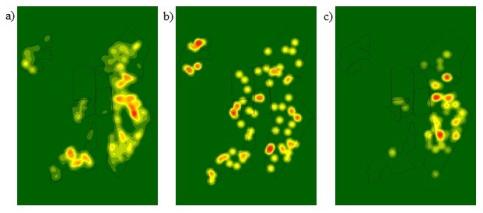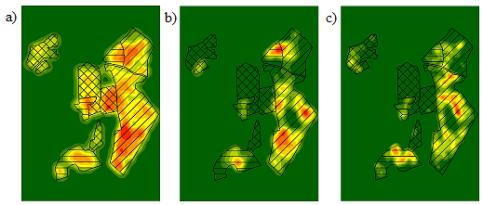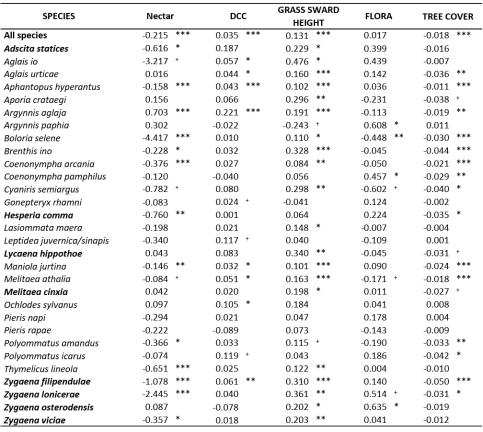Results
4114 butterflies and 39 butterfly species were identified, of which eight are on the Swedish Red List categorized as Near Threatened.
For grass sward height, Dipsacaceae, Centaurea and Cirsium, and number of herbal species the density patterns were the same for all variables: the occurrence of herbal species and the amount of Dipsacaceae, Centaurea and Cirsium were mainly higher in areas where the grass is taller (Figure 1).

Common butterfly species such as Pieris napi and Pieris rapae were found in all pastures, while rare species such as Hesperia comma were mainly concentrated to pastures with higher grass sward height and greater amount of Dipsacaceae, Centaurea and Cirsium (Figure 2).

Areas that were grazed early in the season had in general lower density of herbal species, Dipsacaceae, Centaurea and Cirsium, and butterflies, while highest densities were found in areas that were grazed late in the season (Figure 3).

The generalized linear model for all butterfly species together showed that decreased amount of nectar, higher amount of Disacaceae, Centaurea and Cirsium, higher grass sward height, and less tree cover had significant effects on the presence of species, while the amount of Disacaceae, Centaurea and Cirsium, number of herbal species, and tree cover had no effect. Grass sward height was the factor that significantly affected most butterfly species; 20 species were favoured by a taller grass sward height, while one species was affected negatively. All 18 species that were significantly affected by tree/bush cover were favoured by a more open canopy. Disacaceae, Centaurea and Cirsium showed to have positive significant effect on eleven species, of which one, Zygaena filipendulae, is red listed. The number of nectar giving species had significant effect on seven butterfly species, of which three were affected negatively (Table 1).
Table 1. Estimation values from GLM for all butterfly species used in extraction of values for
Dipsacaceae, Centaurea, and Cirsium, grass sward height, flora, and tree cover. Species in
bold are red-listed species, and symbols indicate significant level: “+” = 0, "*" = 0.1,
"**" = 0.05, "***" = 0.01

Responsible for this page:
Director of undergraduate studies Biology
Last updated:
06/01/17
